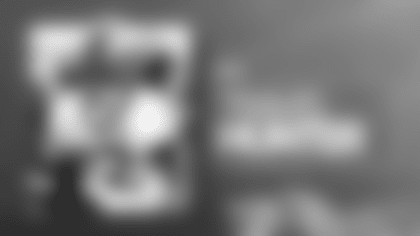Join Jaguars Inside Report Senior Editor Vic Ketchman as he tackles the fans' tough questions.
David from New York, NY:
You only took two questions on 5/10! What's the deal? Don't you know we're starving for information out here. Are you working bankers hours now? I hope you got at least three birdies!
Vic: Due to some kind of mistake of which I was not aware until I got to work this morning, the bulk of yesterday's "Ask Vic" column was omitted from what was published yesterday. What appears below is what was omitted. By the way, I was barraged by e-mails from readers perplexed by yesterday's goof. Some of those e-mails bordered on being irate. Come on, guys, do you honestly think I would do a two-question column? Anyhow, enjoy yesterday's column. I apologize for the error.
Tom from Atlanta, GA:
This was on nfl.com explaining the supplemental draft. Any truth to it? "Each club's draft position is weighted by assigning the weakest club the greatest number of lottery chances and the strongest club the fewest number. Team strength and weakness will be determined by the original order of the first round prior to the April draft and before any trades (i.e., the weakest club, which from the 2003 season is the San Diego Chargers, will have its name in the drawing 32 times, the next weakest 31 times, etc., until the Super Bowl winner, which would have its name in once). There's a three-step drawing process that works in the following order: 1. Teams that won six or fewer games in the prior regular season are placed together in a container and drawn to determine the initial arrangement of places in the selection order. 2. The remaining non-playoff teams are placed together in a container and drawn to determine their places following those determined in the first drawing. 3. Playoff teams are placed together in a container and drawn to determine the remaining places in the selection order."
Vic: That's the long answer. Thanks.
Kevin from Hazleton, PA:
I have sent in so many questions but none of them were answered yet. Please answer this one. What are the odds Tony Brackens will play for Jacksonville this season?
Vic: The odds favor Tony Brackens playing for the Jaguars this season, largely because Brackens attracted almost no interest in free agency. What it comes down to now is Brackens and the Jaguars agreeing to a contract. In my opinion, the Jaguars aren't going to want to pay big for a guy who will also represent a $7 million dead-money hit on the team's salary cap. It's up to Brackens to decide how badly he wants to play this game because his big-money days are over.
Brad from Franklin, TN:
Can a junior out of college not declare himself draft eligible for the April draft and then declare himself eligible for the July draft with the chance of being taken higher and receiving, say, first or second-round money.
Vic: The rule is a player may not bypass the April draft with the intent of applying for eligibility in the July draft, but there are always exceptions to the rule. If an event occurs after the April draft and prior to the July draft, the league may grant eligibility. Such was the case last year with Tony Hollings, who was involved in Georgia Tech's spring practices when he was declared academically ineligible for the 2003 college football season. Hollings sought and was granted eligibility for the July draft, on the basis that it was not his intent to avoid the April draft for the purpose of entering the July draft. All of the supplemental draft rules have a "Bernie Kosar bent" to them. Kosar manipulated the draft process in 1985 when he avoided the April draft, then sought and won eligibility for the supplemental draft. Kosar wanted to play for the Browns, who traded into the top spot in the supplemental draft and selected Kosar.
Dave from Jacksonville:
One more question about the supplemental draft. Is it possible to trade up to get a player?
Vic: Teams may not trade their supplemental draft picks, but they may trade their picks in the April draft which, in effect, would be the equal of assuming each other's positions in the July supplemental draft. Remember, this year's July draft is tied to next year's April draft – you lose the pick in next April's draft that corresponds with the pick you use in this July's draft – so trading picks in next April's draft means assuming each other's picks in this July's supplemental draft. For example, if the Jaguars and the Titans trade first-round picks for next April's draft, the two teams would assume each other's position in this July's supplemental draft. For that trade to apply to the July draft order, however, it would have to be made before the final selection order is determined. As you can tell from the information Tom supplied about determining the final order, it involves a very complicated system that is specifically designed to group teams into one of three categories: those who lost 10 or more games, those who won seven or more games but did not make the playoffs, and those who qualified for the postseason. In other words, a team such as New England can not procedurally claim the first pick of the supplemental draft, and by limiting the impact of trading on the order to before the final order is decided, the league assures a team such as New England can't target the team with the first pick of the supplemental draft and trade with that team. New England could take a gamble and trade with San Diego, but if the Chargers didn't win the lottery and the supplemental draft pool was Jim Brown and five high school kids, the Patriots would've traded away a lot of picks for nothing. The system is designed to protect the league's competitive balance.
David from Woodbridge, VA:
There is much dialogue on the message boards between Jaguars and Titans fans about the number of players under contract for each team. Where do the two teams stand with regards to a full roster and the salary cap?
Vic: The Jaguars are currently $8.9 million under the salary cap and have 87 players signed (that technically includes this year's draft class because those players are considered to have been tendered an offer when they were drafted). The Titans are $500,000 under with 92 signed. I must caution you, however, that these numbers are not nearly as meaningful as fans make them out to be. As explained in "Salary Cap 101," it is each team's projected salary cap that's most important. For example, neither of the $8.9 million and $500,000 figures includes what the two teams will spend on their draft picks. In the Titans' case, the $500,000 also doesn't include what the team will save if it waives Eddie George in June.
Cha Cha from San Diego, CA:
I know fantasy football might not be your deal but do you smell a potential touchdown "vulture" in Greg Jones?
Vic: If you're willing to take the gamble, Greg Jones could end up returning your faith in him in a big way. In my opinion, his value to the Jaguars will be greatest in the role of a short-yardage and goal-line runner. He could end up scoring a lot of touchdowns, just as Stacey Mack did in 2002 when he was the Jaguars' short-yardage and goal-line back. Mack scored nine rushing touchdowns; Fred Taylor scored eight.
Trent from Litchville, ND:
For the players drafted in the supplemental draft, how much would they be looking to get paid?
Vic: Generally speaking, a player selected in the supplemental draft is compensated equal to what a player selected at the corresponding position in the April draft is compensated.
Matthew from Melbourne, Australia:
How come when a quarterback is sacked it counts as negative passing yards instead of negative rushing yards?
Vic: The NFL deducts sacks yardage from yards passing because the quarterback was clearly attempting to pass when he was sacked. College football deducts that yardage from rushing because the ball had yet to be thrown, but, frankly, that's never made much sense to me. Why does the NFL apply scramble yards to rushing yardage? Because at some point in avoiding the rush the quarterback had changed the intent of the play from pass to run. It's all about intent.













